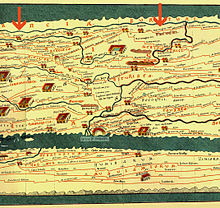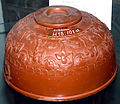Burginatium
| Burginatium | |
|---|---|
| Alternative name | Fort Altkalkar, Fort Kalkar-Altkalkar |
| limes | Lower Germanic Limes |
| Dating (occupancy) | Tiberian until the end of the 4th century |
| Type | Alenkastell |
| unit | a) ala I Noricorum , b) ala Vocontiorum , c) ala Afrorum Veterana |
| size | 150 × 180 m = 2.7 ha |
| Construction | Stone (final phase) |
| State of preservation | no longer visible above ground |
| place | Kalkar-Altkalkar |
| Geographical location | 51 ° 42 ′ 50 " N , 6 ° 19 ′ 8" E |
| height | 17 m above sea level NHN |
| Previous | Steincheshof Fort (northwest) |
| Subsequently | Vetera (southeast) |
The Burginatium was a Roman equestrian camp, a so-called Alenkastell , with around 480 men on the Lower Germanic Limes . Today's soil monument is located in the Altkalkar district of Kalkar in the Kleve district on the Lower Rhine . From the early 1st century to the end of the 4th century it secured the road section between Colonia Ulpia Traiana (today Xanten ) and Ulpia Noviomagus Batavorum (today Nijmegen ) on the Roman imperial road from Lugdunum Batavorum (today Leiden ) and Argentorate (today Strasbourg ).
The etymological origin of the name "Burginatium" goes back to a suffixal development of the Germanic root word "Burg", from which the Latin form burgus is derived.
location
The fort was about 13 kilometers down the Rhine from the Vetera legionary camp near Xanten. The facility, which is no longer visible above ground, is located as a ground monument in Bornschen Feld near Altkalkar between Marienbaum and Kehrum on the banks of the Leybach. It had been erected at the southern foot of a 72-meter-high compression moraine , the Monreberg , on the top of which there was another military camp, which had not been investigated further. Located on a now silted meander of the Rhine , which has shifted its course to the east since Roman times, the site occupies an area of around three hectares.
Research history
Burginatium is listed on the Tabula Peutingeriana and in the Itinerarium Antonini . The latter shows the assignment with an ala . The location of the place is known from time immemorial. Calculations by the city of Kalkar for the 16th century show that the ruins that were still visible at that time were used as a quarry. Various emergency excavations by the Rheinisches Landesmuseum Bonn and the Rhineland Regional Association due to construction work after the Second World War gave an incomplete picture of the facility. No excavations have taken place in this area to this day.
history
The camp was probably founded under Tiberius (14–37). This assumption is supported by ceramic finds from the fort area, which are dated to the Augustan- Tiberian period. On the basis of the rest of the inventory, a continuous occupancy up to the end of the 4th, perhaps until the turn of the 5th century, can be assumed. The coin series begins with Caesarian issues. The final coin is from the time of the late antique emperor Honorius .
The Ala I Noricorum , Ala Vocontiorum and Ala Afrorum Veterana are documented as crews one after the other for the end of the 1st and the beginning of the 2nd century .
investment
Fort
Only the last, late antique construction phase of the fort is known so far. Its defense consisted of a stone wall, which was surrounded by a double pointed ditch. The fortification encompassed an area of approximately 150 × 180 meters. The Leybach formed the western border of the camp. On both sides of the central camp street were the team barracks with counter-bernias in half-timbered construction, which offered space for about 480 soldiers, the strength of an ala quingenaria . The findings suggest that these barracks burned down several times.
Vicus and burial ground
The camp village ( vicus ) surrounded the fort in a semicircle in the northeast to southwest. The associated grave fields were on the Monreberg and on the neighboring Pierenberg. Another cemetery stretched along Limesstrasse, today's Bundesstrasse 57 in the Kehrum district.
Finds
A Mithras stone from the 3rd century comes from the area of the camp service , which served as the base of a bronze statue. The find inventory also includes a bronze figure of a kneeling giant . With an inscription found during excavations in Burginatium, the worship of the Germanic war goddess Vagdavercustis could be proven.
Monument protection and remains
The fort and the area of the camp service are ground monuments according to the law for the protection and care of monuments in the state of North Rhine-Westphalia (Monument Protection Act - DSchG) . Research and targeted collection of finds are subject to approval. Incidental finds are to be reported to the monument authorities.
Some of the finds from Burginatium are exhibited in the Kalkar Municipal Museum .
- Roman finds from Burginatium in the Kalkar Municipal Museum
See also
literature
- Michael Gechter : The beginnings of the Lower Germanic Limes. In: Bonner Jahrbücher 179, 1979, Rheinland-Verlag, Bonn 1979, p. 110 ff.
- Michael Gechter: Kalkar-Altkalkar. In: Heinz Günter Horn : The Romans in North Rhine-Westphalia . Theiss, Stuttgart, 1987, ISBN 3-8062-0312-1 , p. 452
- Heinz Günter Horn : Excavations in the Rhineland 1983/84. Exhibition Rheinisches Landesmuseum Bonn 1985. Bonn 1985, ISBN 978-3-7927-0852-1 , p. 151 ff.
- Harald von Petrikovits : The Roman Rhineland. Supplement Bonner Jahrbücher 8, 1960, Rheinland-Verlag, Bonn 1960, p. 47 ff.
- Rudolf Pörtner : The Alenlager Burginatium (Altkalkar). In: Guide to Prehistoric and Protohistoric Monuments . Vol. 14: Left Lower Rhine . Zabern, Mainz 1969, pp. 198-201.
- Hans-Helmut Wegner : Kalkar-Altkalkar - Burginatium . In: Julianus Egidius Bogaers and Christoph B. Rüger (eds.): The Lower Germanic Limes. Materials on its story. Rheinland-Verlag, Cologne 1974, ISBN 3-7927-0194-4 , pp. 101-104
Individual evidence
- ^ Rudolf Pörtner: The Alenlager Burginatium (Altkalkar). In: Guide to Prehistoric and Protohistoric Monuments . Vol. 14: Left Lower Rhine . Zabern, Mainz 1969, p. 198.
- ^ Tilmann Bechert : Roman Germania between the Rhine and the Maas. Munich 1982. ISBN 3-7774-3440-X . P. 79.
- ↑ CIL 13, 08669 , L (ucius) Carantiu [s 3] / f (ilius) Senecio R [aura] / cus (?) Eq (ues) alae N [ori] / cor (um) anno (rum) XXX [ 3] / h (eres) d (e) s (uo) , and CIL 13, 08670 , C (aio) Iulio Adari f (ilio) / Primo Trevero / eq (uiti) alae Noric (orum) / statori an (norum ) XXVII / stip (endiorum) VII h (eres) a (ere) s (uo?) F (aciendum) c (uravit) .
- ↑ CIL 13, 08671 : Atil [l] us Di (vi) x / ti f (ilius) m [i] ssicius / ala (e) [V] ocon <ti = IT> (i) / hic [si] tus est .
- ↑ CIL 16, 00059 : Imp (erator) Ca [esar divi Nervae f (ilius) Nerva Traianus] / Aug (ustus) Ge [rm (anicus) Dacicus pontif (ex) maximus tribunic (ia)] / potes [tat (e ) 3 imp (erator) 3 co (n) s (ul) 3 p (ater) p (atriae)] / equit [ibus et peditibus et classicis? qui mil] / itave [runt in alis 3 et cohortibus] decem [quae appellantur 3] / et Af [rorum veterana et 3 et sunt in Germania inferiore sub // Imp (erator) Caesar div [i Nervae f (ilius) Nerva Trai ] / anus Aug (ustus) Ger [m (anicus) Dacicus pontif (ex) maximus] / tribunic (ia) pot [es [tat (e) 3 imp (erator) 3 co (n) s (ul) 3 p ( ater) p (atriae)] / equitibus et p [editibus et classicis?] / qui militave [runt in alis 3 et] / [coh] o [rtibus] decem [quae appellantur 3] / et Af [rorum veterana et 3 et sunt in Germania inferiore sub .
- ^ Rudolf Pörtner: The Alenlager Burginatium (Altkalkar). In: Guide to Prehistoric and Protohistoric Monuments . Vol. 14: Left Lower Rhine . Zabern, Mainz 1969, pp. 199-200.
- ↑ Michael Gechter: Kalkar-Altkalkar. In: Heinz Günter Horn : The Romans in North Rhine-Westphalia . Theiss, Stuttgart, 1987, ISBN 3-8062-0312-1 , p. 452.
- ↑ Richard Gordon: Viewing Mithraic art: The altar from Burginatium (Kalkar), Germania Inferior. In: Arys Vol. 1 (1998), pp. 227-258.
- ↑ AE 2003, 01227 : Va] gda / [ve] rcust [i] / [Ca] ndidiu [s] / [––– .
- ↑ Gabriele Uelsberg: War and Peace. Celtic-Roman-Germanic tribes. Catalog of the exhibition in the Rheinisches Landesmuseum Bonn. Bonn and Darmstadt 2007. ISBN 3-89678-349-1 , p. 291.
- ↑ Law on the protection and maintenance of monuments in the state of North Rhine-Westphalia (Monument Protection Act - DSchG)










